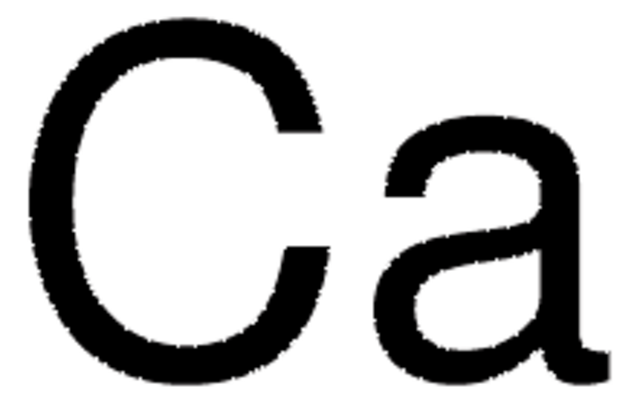441872
Calcium
dendritic pieces, purified by distillation, 99.99% trace metals basis
Synonym(s):
Atomic calcium, Calcium element
About This Item
Recommended Products
Quality Level
Assay
99.99% trace metals basis
form
dendritic pieces
purified by
distillation
reaction suitability
reagent type: reductant
resistivity
3.5 μΩ-cm, 20°C
bp
1484 °C (lit.)
mp
850 °C (lit.)
density
1.54 g/mL at 25 °C (lit.)
SMILES string
[Ca]
InChI
1S/Ca
InChI key
OYPRJOBELJOOCE-UHFFFAOYSA-N
Looking for similar products? Visit Product Comparison Guide
General description
Application
- Process control agent in mechanical alloying of titanium to get maximum powder yield and microstructural stability.
- A precursor to synthesize Ca8Al3 and Ca13Al14 with metallic Zintl phases and Ca6.2Mg3.8Sn with an unprecedented type of tin chain composed of square-planar tin units.
- A catalyst in the highly selective oxidation of phenols.
accessory
Signal Word
Danger
Hazard Statements
Precautionary Statements
Hazard Classifications
Water-react 2
Storage Class Code
4.3 - Hazardous materials which set free flammable gases upon contact with water
WGK
WGK 1
Flash Point(F)
Not applicable
Flash Point(C)
Not applicable
Personal Protective Equipment
Regulatory Listings
Regulatory Listings are mainly provided for chemical products. Only limited information can be provided here for non-chemical products. No entry means none of the components are listed. It is the user’s obligation to ensure the safe and legal use of the product.
FSL
Group 3: Spontaneously combustible substances and water- reactive materials
Alkali metals (except potassium and sodium) and alkaline earth metals
Hazardous rank I
1st spontaneously combustible materials and water reactive materials
ISHL Indicated Name
Substances Subject to be Indicated Names
ISHL Notified Names
Substances Subject to be Notified Names
JAN Code
441872-25G-PW:
441872-5G:
441872-VAR:
441872-5G-PW:
441872-25G:
441872-BULK:
Choose from one of the most recent versions:
Already Own This Product?
Find documentation for the products that you have recently purchased in the Document Library.
Customers Also Viewed
Our team of scientists has experience in all areas of research including Life Science, Material Science, Chemical Synthesis, Chromatography, Analytical and many others.
Contact Technical Service









